Papers by Aníbal Rosario Lebrón
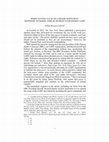
FloridaLaw Review Forum, 2023
In her article, Expanding LGBT, Professor George attempts to provide a framework beyond increment... more In her article, Expanding LGBT, Professor George attempts to provide a framework beyond incrementalism and radicalism to think about how U.S. LGBT organizations can reformulate their missions and advocacy efforts to benefit queer individuals. She argues that doing so will not only better the lives of queer non-binary, intersex, and asexual people, but also the more marginalized individuals within the LGBT community (i.e., trans and bisexual folks). As a departing point for her proposal, she uses the incorporation, about two decades ago, of the trans community into the U.S. national LGB movement.
This response focuses on three interrelated aspects that George’s article does not explore. First, whether it is possible or advisable that, in lieu of the expansion of the LGBT movement to LGBTQIA, we transition to a movement focused on inequality in general with an emphasis in sexual orientation and gender identity and expression (SOGIE) equality. Second, the effects the historical context has on conditioning the different alternatives discussed for movement expansion. Third, whether the current social landscape could mean a setback in SOGIE equality if movements continue their advocacy with limited representation of the more marginal members of the LGBT community.
Social Science Research Network, 2004
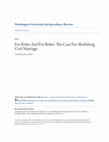
Washington University Jurisprudence Review, 2012
Non-traditional family arrangements are currently denied legal and social recognition as families... more Non-traditional family arrangements are currently denied legal and social recognition as families. This lack of recognition comes from their failure to meet the standard of the prevailing matrimonial-family model. As a result, these families face a very inequitable society that discriminates toward them in every turn. Furthermore, the legal fixation to promote a specific model of the family has produced a very incoherent legal scheme. This article explores whether a more egalitarian society and a more sound legal system may be achieved by extending the protections and benefits of marriage to more groups or, alternatively, whether it would be better to abolish civil marriage in order to achieve such a goal. Instead of following a liberal framework, the article examines the problem from a Neo-Marxist perspective; specifically, Gramsci's ideas of hegemony and
Family Court Review, Oct 1, 2022
Social Science Research Network, Jan 31, 2011

Family Court Review, 2022
In this article, I explain how I came to redefine my teaching philosophy as Fem-Crit to ensure th... more In this article, I explain how I came to redefine my teaching philosophy as Fem-Crit to ensure that I train students in gender-conscious lawyering. First, I discuss how even though Crits' and Feminists' pedagogical approaches focus on breaking down hierarchies in the law, Crit pedagogies can remain male-constructed and privileged, especially for cis-man professors like myself. Recognizing these shortcomings, I highlight the importance of labeling my teaching as Fem-Crit as a self-accountability measure. Departing from this understanding, I revisit my conclusion from a previous article that the law school classroom should be a battlefield and recognize that a Fem-Crit formulation of the classroom encompasses more than conflict and it also includes meeting conflict with anti-subordination responses. I follow with my reflections on the challenges, methods, and experiences in socializing students to become Fem-Crit lawyers. In that part, I discuss how each of the tenets that I had previously identified as core components of a Crit classroom should look for a Fem-Crit professor. I conclude my reflection by sharing how Fem-Crit pedagogy has led me to believe that this didactic practice ultimately entails bringing activism into the classroom and the classroom into activism.
LSU Journal for Social Justice & Policy, 2022
This article addresses how racial subordination is embedded in the United States’ evidentiary sys... more This article addresses how racial subordination is embedded in the United States’ evidentiary system. Using a Critical Race Theory framework, it shows how the Rules of Evidence, under the guise of neutrality, promote racial injustice by privileging whiteness, penalizing nonwhiteness, allowing racialized evidence, and disallowing proof of racial bias during trials. The article proffers a framework for legal reforms based on the creation of race-conscious evidentiary rules.

This article assesses the state of affairs in post-revolutionary Cuba of one of the highest ideal... more This article assesses the state of affairs in post-revolutionary Cuba of one of the highest ideals of the contemporary Western society, equality between the sexes. The paper first discusses socialism and its relationship with the feminist movement as well as the role of the law within the Marxist-Leninist thought, which is the basis of the Cuban government. In addition, the paper offers a short historical account of the situation of Cuban women before the Revolution. Then an analysis of the situation of women during the forty-five years following the Revolution is proffered. The inquiry is divided by examining the situation in both the public and the private sphere. The paper utilizes as a theoretical framework for its analysis Christine A. Littleton’s theory of symmetrical and asymmetrical systems of equality. The paper concludes that the struggle for gender equality after the revolution in Cuba allowed Cuban women to achieve a high degree of equality when compared with their count...

This article analyzes how the concept of family displayed in the Puerto Rican legal system as wel... more This article analyzes how the concept of family displayed in the Puerto Rican legal system as well as the underlying reasons for its regulation clash with the basic formulations of the liberal State. The discussion departs from the statements made by the Speaker of the Senate of Puerto Rico, Thomas Rivera Schatz, to the extent that the recently appointed Justices of the Supreme Court of Puerto Rico will defend the rights of the Puerto Rican family, and the traditional values of the family, and not the twisted family that some wish to be impose in Puerto Rico by court and/or legislative action. First, the article shows how the State recognizes, contrary to what the senator argues, that there is more than one possible family arrangement. It also highlights the fact that there is not an unequivocal legal definition of family. However, the article stresses how the State dictates through its policies, public campaigns, the research it supports, the curricula of schools, and/or the artist...

The evolution of legislation on sexual crimes shows that only two approaches have been used to ad... more The evolution of legislation on sexual crimes shows that only two approaches have been used to address this issue: the medical and criminal approach. These approaches, however, have proven to be ineffective when used independently or jointly to resolve the problem of sex offenses. The failure of these approaches is not a coincidence. It is the direct effect of the social construction of sex offenders. Today, society promulgates the myth that once a sex offender always a sex offender, which means that these individuals are innately incapable of changing their behavior. This construct generates feelings of rejection, fear and discrimination toward sex offenders. These social feelings are incorporated into the law, precluding the government from dealing with the problem itself. However, as history demonstrates the social construction of sex offenders is a mutable concept. Thus, this paper argues that the best approach to address the issue of sex offenses is to engage in a therapeutic a...

“You hear it said that fathers want their sons to be what they feel they themselves cannot be, bu... more “You hear it said that fathers want their sons to be what they feel they themselves cannot be, but I tell you it also works the other way.” With those simple words in one of the most heartfelt self-discovery stories in “American” literature, Sherwood Anderson subtly unmasked how yearnings and aspirations are a two-way street. As parents project their aspirations upon their children, so do their children upon them. The same holds true for teachers and students, especially in legal academia. As law professors, we have a specific idea of what type of learners and legal professionals law students should be; but just as daughters and sons, law students also have in their minds an ideal law professor. However, when these aspirations and ideals do not correspond with each other, conflict usually ensues, as it did for the young man in Sherwood Anderson's Discovery of a Father. This conflict puts a strain on any relationship and creates a tense atmosphere that can dampen communication. In the case of parents and their children, this might be resolved with time or a serendipitous event that reopens the communication channels and sheds light on the reasonableness of their yearnings--as a young Sherwood discovered himself. Yet, in the classroom, time is always pressing and those types of serendipitous events are scarce. Nonetheless, most of us who have been in a classroom feel that students and professors must find a way to deal with their mismatched ideals. We believe that otherwise the classroom would become a minefield in which tensions and conflict fly and explode, leaving learning eroded In some instances, as it happened during Greg Mankiw's 2011 Introductory Economics class at Harvard, such explosions take very tangible forms such as a staged walkout to demonstrate the disconnect between the professor's vision of the class and the profession vis-a-vis the students'. In most instances, however, both sides subtly express their discomfort daily, in ways that could be thought to discourage the parties from engaging in the learning process or distract them from the pedagogic endeavor. These inevitable subtle confrontations and understated discomforts, however, are seldom memorialized except for students' evaluations, which are archived and used strategically to grant tenure or not. Most of the time, we experience them as derisory remarks such as, “You don't do things like most professors or like X professor (the epitome of the ideal law professor),” or, “You should take this matter seriously even if it won't be tested on the bar; it will be important in your lives as attorneys,” that are said and disregarded as they do not seem to pertain to the teaching or learning experience. Rarely, we read accounts in the legal pedagogy scholarship about the customary confrontations between students and professors predicated on their divergent visions of the Law, the profession, and pedagogic practices. Most of the scholarship in this area is dedicated to apolitical/neutral issues such as teaching effectiveness, practice-ready attorneys, bar passage rate, job placement, and student satisfaction. Seldom do legal scholars problematize these accounts of confrontation and delve into what they mean in terms of our didactic practices. Instead, students' voices are buried in the bureaucratic exercise of collecting complaints and accolades to measure effectiveness, and professors' accounts are left for side faculty meeting conversations and building camaraderie by sharing war stories. This is why the Economics 101 walkout was so pivotal in triggering this article's reflection about what the Law-Crit classroom is and what it should be. In a rare turn of events, we were witnesses to both the professor's and the students' versions of on-going class conflicts that were prompted by their mismatched philosophical and pedagogical views. The students alleged that they were discontent with the inherent bias in their introductory economics course that did not include a critical perspective that would allow them to assess the flaws and benefits of prevailing economic models and alternative ones. As a way to express their discontent in a more tangible manner, they staged a walkout. When I read the news about their walkout, I was envious of Professor Mankiw. As a teacher that self-identifies as a Crit scholar and professor, I had wished many times for students like Mankiw's discontented pupils. I constantly long for students who would appreciate the value of a critical education instead of discarding it as a futile exercise or describing it as a political agenda that has no room in the classroom, and who would go the extra mile to defend it. However, as a teacher I felt for Mankiw and wondered how I would react if I have to face such a confrontation. Many times I have faced the students' rejection of the discussion of critical scholarship, the inclusion of non-canonical narratives, or the use of critical pedagogical strategies. Those moments of…
University of Miami law review, 2019
The #MeToo movement has drawn attention to the prevalence of sexual and gender-based violence. Bu... more The #MeToo movement has drawn attention to the prevalence of sexual and gender-based violence. But more importantly, it has exposed how society discounts the testimony
Feminist Judgments: Family Law Opinions Rewritten, 2020
I got the subject of people living together out of the closet and right down at your dinner table... more I got the subject of people living together out of the closet and right down at your dinner table. Women and men now talk about it openly. They discuss what they want out of a relationship." 1 Perhaps no other case in family law has been so intertwined with popular culture than Marvin v. Marvin. 2 The decision that had as protagonists Hollywood's star Lee Marvin, performer Michelle Triola Marvin, 3 and celebrity lawyer Marvin M. Mitchelson, has been, for the past four decades, the subject of popular shows, 4 news outlets, 5 and songs. 6 It introduced a neologism into our legal and lay dictionaries, the concept of palimony (an acronym of pal and alimony). 7 But more importantly, Marvin holds a seminal place in family law regarding the rights of nonmarital cohabiting couples.
Tulane Journal of Law & Sexuality, 2021
This essay explores how identity conversations could perpetuate the discrimination they seek to e... more This essay explores how identity conversations could perpetuate the discrimination they seek to eradicate ad what can be done to avoid it.
Rewritten Opinions of the United States Supreme Court, 2000
product of private relationships and not subject to either federal regulation or public interfere... more product of private relationships and not subject to either federal regulation or public interference. 76 Any attempt to remedy violence against women, or the bias they experience in the judicial system, will only be effective when there is a realization that violence against women reflects, "as much a failure of our Nation's collective willingness to confront the problem as it does the failure of the Nation's laws and regulations." 77 AMBRE HOWARD 76.
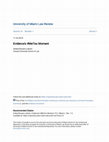
University of Miami Law Review, 2019
The #MeToo movement has drawn attention to the prevalence of sexual and gender-based violence. Bu... more The #MeToo movement has drawn attention to the prevalence of sexual and gender-based violence. But more importantly, it has exposed how society discounts the testimony of women. This Article unfolds how this credibility discounting is reinforced in our evidentiary system through the use of character for untruthfulness evidence to impeach victims. Specifically, through defense attorneys’ practice of impeaching sexual and gender-based violence victims’ character for truthfulness as a way to introduce functional evidence of credibility biases regarding the trustworthiness of sexual and gender-based violence victims and the plausibility of their testimonies. The Article further shows a correlation between the poor performance of our legal system in redressing the harms associated with sexual and gender-based violence and our evidentiary rules. Accordingly, the Article advocates reforming the use of character for untruthfulness evidence and proposes a rule that attempts to temper the prejudicial effects caused by long-held credibility biases against sexual and gender-based violence victims with a well-established impeachment tradition, constitutional protections, and judicial efficiency. It does so in hopes that the #MeToo movement becomes a catalyst in the judicial response against sexual and gender-based violence.
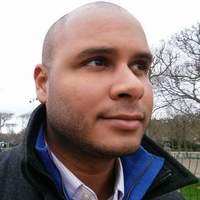



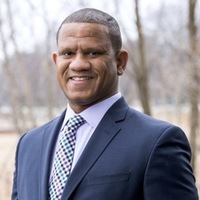


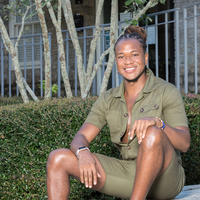
Uploads
Papers by Aníbal Rosario Lebrón
This response focuses on three interrelated aspects that George’s article does not explore. First, whether it is possible or advisable that, in lieu of the expansion of the LGBT movement to LGBTQIA, we transition to a movement focused on inequality in general with an emphasis in sexual orientation and gender identity and expression (SOGIE) equality. Second, the effects the historical context has on conditioning the different alternatives discussed for movement expansion. Third, whether the current social landscape could mean a setback in SOGIE equality if movements continue their advocacy with limited representation of the more marginal members of the LGBT community.
This response focuses on three interrelated aspects that George’s article does not explore. First, whether it is possible or advisable that, in lieu of the expansion of the LGBT movement to LGBTQIA, we transition to a movement focused on inequality in general with an emphasis in sexual orientation and gender identity and expression (SOGIE) equality. Second, the effects the historical context has on conditioning the different alternatives discussed for movement expansion. Third, whether the current social landscape could mean a setback in SOGIE equality if movements continue their advocacy with limited representation of the more marginal members of the LGBT community.